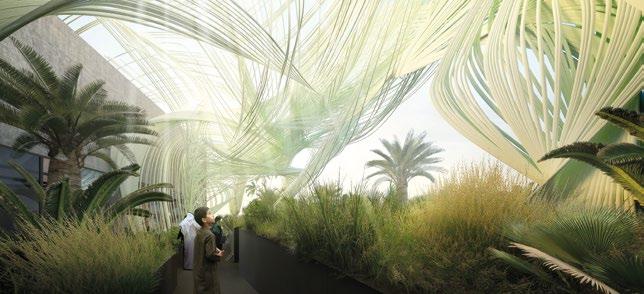
4 minute read
ABESS - WATER REUSE AND CARE
EXPO 2020

Advertisement
element in the Relaxation Zone, where visitors will be able to sit on a raised platform in comfortable seats, relax and enjoy the view of the rest of the exhibition. The last indoor exhibit is a glass sculpture by Vlastimil Beránek called ICE, which prides itself on the title of the world´s largest polished glass sculpture.
S.A.W.E.R.
Today, turning the hot, arid desert into greenland may seem a dream or a fairy tale. In practice, such transformation would need a huge quantity of water. The question is, how can such volumes of water be come by in the desert? From the air with the help of the Sun! Yes indeed, this is possible, because even in the desert the air contains water vapour. But the problem is that climatic conditions in the desert do not make it possible to obtain water from the air easily with the aid of an ordinary cooler, on the surface of which the water will condense at a low temperature. This is possible in European climatic conditions, but not in an arid area suffering from water shortage. Equipment making it possible to transform an arid desert into an oasis by the targeted multiplication of microorganisms may sound like sci-fi. In actual fact, research and development are partly inspired by sci-fi envisaging new technologies of the future. S.A.W.E.R., or Solar Air Water Earth Resource, consists of two systems: one for obtaining water from desert air and the other for cultivating the desert into fertile soil. The system for obtaining water from the air, the development of which the University Centre of Energy Efficient Buildings (UCEB) and the Engineering Faculty of Prague´s Technical University (ČVUT) in collaboration with the Botanical Institute of the Czech Academy of Sciences are working on, is a two-stage system,
which uses a desiccant – material which in the first stage binds water vapour on its surface by adsorption. The desiccant removes water from the ambient air and retains it on its surface, with the dehumidified air being returned to the ambient milieu. At the same time, more of the ambient air with its natural water vapour content first has to be heated to a temperature allowing water vapour to be released from the surface of the desiccant, and thus humidifying the desert air. This process takes place at a raised temperature. The desert air binds a higher quantity of water vapour, so that the air coming to the cooler contains more moisture than the ambient desert air. That is why much more water can be obtained from the cooler by condensing water from the air. While an ordinary cooler can produce 10 litres of water a day from desert air on an average, the amount obtained from S.A.W.E.R is up to 200 l/day on an average, at comparable flows of treated air. The main specific feature of the S.A.W.E.R. system is autonomous operation. The energy needs of the system are fully covered by solar energy (solar photothermal collectors, photovoltaic modules, heat and electric energy accumulation). Side products of the technological system are warm water for showering and cold air for air conditioning of the building. Prague´s Botanical Institute at the Czech Academy of Sciences is developing a system for desert cultivation, which uses a part of the water obtained for a special photo bioreactor, an artificial environment serving the cultivation of microalgae used for polysaccharide production and for the retention of nutrients in water. The mixture of water, algae and organically-bound nutrients is applied by means of a watering system installed about 20 cm below the soil surface. Roots receive the water with nutrients directly from the water piping. This greatly reduces the loss of water caused by evaporation, which is important especially in dry areas with high levels of sunlight exposure. The effect of irrigation with water containing algae is that the soil will receive both nutrients released at a slow pace, as well as other substances contained in algae, such as plant hormones and organic matter needed for the good growth of plants. Before planting the plants, sandy soils should be revived by microorganisms, which are beneficial for the growth of plants, helping them to absorb nutrients more efficiently and retaining more water in the layer of soil around the roots. These organisms, soil symbiotic mycorrhizal and endophytic fungi acting in the root system, together with other soil organisms, will revive the soil to such a degree that it will become suitable for cultivation even in extreme conditions such as those found in the desert.
Photo: Office of the General Commissioner of Czech participation at the General World Exposition EXPO
24 Czech Republic – Your Trade Partner

Czech Republic – Your Trade Partner 25





